With Identities, the Chicago Sinfonietta continues its global search for diverse voices working in classical music. For our final concert of the 2013-14 Season, we look at how traditions of art and culture define our sense of who we are and the way those traditions both connect us to our heritages and inform our present day lives. To do so, we look to two very different societies connected only by the Silk Road, China and Jewish Eastern Europe. We’ll perform 21st century works that are deeply tied to their ethnic traditions as well as an early 20th century classic also from Eastern Europe that remains a deep source of pride in its homeland.
ARTISTS
Mei-Ann Chen, Music Director and Conductor
 Maestro Mei-Ann Chen completes her third season as the Sinfonietta’s Music Director in much the same way as she was introduced to us as a guest conductor nearly 5 years ago. In October of 2009, the Taiwan-born Chen led the orchestra in West Meets East, a concert that paired two works written by contemporary Chinese composers with two from the Western classical tradition. No one who was there will forget the dramatic opening that featured An-Lun Huang’s Saibei Dance or the intricate interplay of erhu soloist Betti Xiang and the orchestra. (Saibei Dance was later recorded and released on the Chicago Sinfonietta’s Delights & Dances CD.) At the same time, her spirited conducting of pieces by Rachmaninoff and Ravel revealed her to be thoroughly immersed and in firm command of Western classical repertoire.
Maestro Mei-Ann Chen completes her third season as the Sinfonietta’s Music Director in much the same way as she was introduced to us as a guest conductor nearly 5 years ago. In October of 2009, the Taiwan-born Chen led the orchestra in West Meets East, a concert that paired two works written by contemporary Chinese composers with two from the Western classical tradition. No one who was there will forget the dramatic opening that featured An-Lun Huang’s Saibei Dance or the intricate interplay of erhu soloist Betti Xiang and the orchestra. (Saibei Dance was later recorded and released on the Chicago Sinfonietta’s Delights & Dances CD.) At the same time, her spirited conducting of pieces by Rachmaninoff and Ravel revealed her to be thoroughly immersed and in firm command of Western classical repertoire.
With Identities, Mei-Ann returns to Chinese tradition for inspiration but also puts a twist on the West with contemporary pieces grounded in the klezmer tradition, once again proving that she is always up to the challenge of discovering and performing new works from diverse sources. In her brief time leading the Chicago Sinfonietta, the orchestra has won two awards from the League of American Orchestras: A First Place Award for Programming of Contemporary Music and the Helen M. Thompson Award, which acknowledged Maestro Chen’s impact on the Sinfonietta and potential for an important international national career.
Mei-Ann Chen’s complete biography can be found here.
In this video clip, Mei-Ann talks about the concert, its music and its participants.
Maxwell Street Klezmer Band
Alex Koffman, Musical Director and Violin
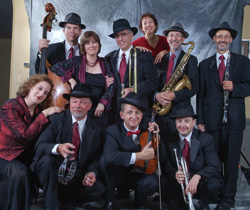 The Maxwell Street Klezmer Band has been practicing the art of klezmer music since 1983. Founded in Chicago by Lori Lippitz, the band began to blossom in 1990 when violinist Alex Koffman, a graduate of the Minsk Conservatory of Music in Belarus, immigrated to Chicago and joined as Musical Director. Over the years, the band has performed across the country and in Europe, including Carnegie Hall, Lincoln Center, the Barbican Centre, the Vienna Concert House, and, in Chicago, Symphony Center and the Old Town School of Folk Music. The Maxwell Street Klezmer Band has five recordings of authentic klezmer and original compositions. Klezmer Rhapsody, which appeared on the band’s 2002 CD Old Roots New World, was written by Ilya Levinson for Alex Koffman and had its premiere in 1999 as an orchestral concerto with Koffman as principal soloist, a role he will repeat in the Sinfonietta performance.
The Maxwell Street Klezmer Band has been practicing the art of klezmer music since 1983. Founded in Chicago by Lori Lippitz, the band began to blossom in 1990 when violinist Alex Koffman, a graduate of the Minsk Conservatory of Music in Belarus, immigrated to Chicago and joined as Musical Director. Over the years, the band has performed across the country and in Europe, including Carnegie Hall, Lincoln Center, the Barbican Centre, the Vienna Concert House, and, in Chicago, Symphony Center and the Old Town School of Folk Music. The Maxwell Street Klezmer Band has five recordings of authentic klezmer and original compositions. Klezmer Rhapsody, which appeared on the band’s 2002 CD Old Roots New World, was written by Ilya Levinson for Alex Koffman and had its premiere in 1999 as an orchestral concerto with Koffman as principal soloist, a role he will repeat in the Sinfonietta performance.
Klezmer is a combination of the Hebrew words "kley" (vessel) and "zemer" (melody), describing musical instruments in ancient times. It came to be used to describe Jewish folk musicians sometime in the Middle Ages. In the 1970s, “klezmer music” and “klezmer band” were terms coined to describe the revival of Eastern European dance music and Yiddish folk and theater songs. It’s a rollicking sound that shares much with jazz and Latin music. Besides violin, the most recognizable element is likely the clarinet, but other horns such as trumpet, sax and trombone also figure strongly. I’m going to go out on a limb here and suggest that the King of Swing himself, Benny Goodman, probably first heard a clarinet at a family wedding.
The band has an information packed website of their own. To underscore the klezmer-jazz connection, check out the way this traditional tune starts off by quoting Gershwin’s Rhapsody in Blue in this video.
Su Chang, guzheng
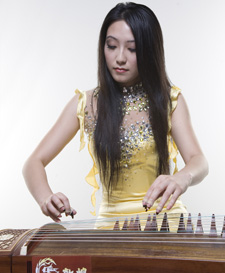 Internationally-renowned guzheng virtuoso Su Chang began her study of the instrument at age six, and has performed both solo and in accompaniment to orchestras worldwide. The guzheng is a Chinese zither that is an ancestor to instruments such as the Japanese koto, Korean gayagaeum and Vietnamese đàn tranh. Su Chang’s notable engagements around the globe include being a featured soloist in the YouTube Symphony orchestra's 2010 concert in Sydney under the baton of Michael Tilson Thomas, and a personal invitation from Oscar-winning composer Tan Dun to perform in the 2012 Zurich premiere of a new work. She has also performed with Grammy-winning artist Kitaro, and tours internationally with the pop/Chinese folk ensemble The VIVA Girls. Ms. Chang premiered the Identity concerto in 2010 with the New York Philharmonic, and has been the soloist at every subsequent performance.
Internationally-renowned guzheng virtuoso Su Chang began her study of the instrument at age six, and has performed both solo and in accompaniment to orchestras worldwide. The guzheng is a Chinese zither that is an ancestor to instruments such as the Japanese koto, Korean gayagaeum and Vietnamese đàn tranh. Su Chang’s notable engagements around the globe include being a featured soloist in the YouTube Symphony orchestra's 2010 concert in Sydney under the baton of Michael Tilson Thomas, and a personal invitation from Oscar-winning composer Tan Dun to perform in the 2012 Zurich premiere of a new work. She has also performed with Grammy-winning artist Kitaro, and tours internationally with the pop/Chinese folk ensemble The VIVA Girls. Ms. Chang premiered the Identity concerto in 2010 with the New York Philharmonic, and has been the soloist at every subsequent performance.
Video excerpts of Su Chang performing Identity can be found in the composer section of this guide. For something a bit different, she can be seen and heard here in this music video for the VIVA Girls, an all female, 12 member conservatory-trained ensemble that plays pop tunes on traditional Chinese instruments. Unlikely as that may sound, it’s actually pretty neat stuff. Think somewhat more serious (but still glamorous) K-Pop but with instrumental prowess substituted for the singing and dancing. That’s her in the middle.
COMPOSERS
Ilya Levinson
Shtetl Scenes and Klezmer Rhapsody
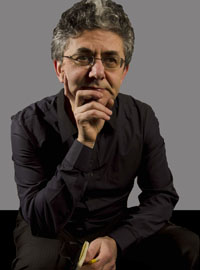 Russian-born Ilya Levinson graduated from the Moscow State Conservatory as a composer. After immigrating to the United States in1988, he completed a Ph.D. in Composition at the University of Chicago. Levinson’s catalogue includes operas, musicals, various symphonic and chamber music, film scores and original music for theatre productions. Levinson’s music has been performed in the United States and Europe by Russian State Symphony Orchestra, Sarajevo Philharmonic, Yaroslavl Symphony, Civic Orchestra of Chicago, Lincolnwood Chamber Orchestra, Tononi Ensemble, Duo Montagnard, and iAN&ANi Duo among others.
Russian-born Ilya Levinson graduated from the Moscow State Conservatory as a composer. After immigrating to the United States in1988, he completed a Ph.D. in Composition at the University of Chicago. Levinson’s catalogue includes operas, musicals, various symphonic and chamber music, film scores and original music for theatre productions. Levinson’s music has been performed in the United States and Europe by Russian State Symphony Orchestra, Sarajevo Philharmonic, Yaroslavl Symphony, Civic Orchestra of Chicago, Lincolnwood Chamber Orchestra, Tononi Ensemble, Duo Montagnard, and iAN&ANi Duo among others.
Levinson is Assistant Professor and Acting Director of Composition Studies at Columbia College Chicago. His research interests include klezmer music and the klezmer idiom in contemporary concert music. Before we get to that, though, the orchestra will perform two movements from Levinson’s 2005 work Shtetl Scenes. ‘Shtetl’ is a Yiddish word that refers to a small Jewish village in pre-World War II Europe. Forgotten Dreams imagines an idealized life in one of these places that were lost to the Holocaust, even as that memory slowly slips away, while Freylakh is a lively dance, full of rhythm and joy. Originally written as a piano cycle, the Sinfonietta performance features a full orchestration.
Klezmer Rhapsody has an interesting history. It originally premiered in 1999 as a klezmer-based piece for violin and orchestra. Maxwell Street Klezmer Band’s musical director Alex Koffman provided considerable guidance and was the violin soloist for that premiere. It then appeared, sans orchestra, on Maxwell Street’s 2002 album Old Roots New World. The Sinfonietta performance is yet a third, brand new version, this time for klezmer band and orchestra. For it, Levinson has thoroughly reworked and re-conceptualized the piece to take advantage of the dynamic interplay between the two ensembles.
Ilya Levinson maintains his own website with his full biography, list of works, sound clips and news about his projects. The video is of the original piano trio version of Shtetl Scenes second movement.
Victor Cheng and Michael Gordon Shapiro
Identity: Zhongshang Zhuang
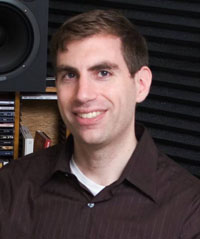 Identity: Zhongshang Zhuang is an effort to combine the musical traditions of Western and Chinese culture in a piece that is accessible to international audiences. A romantic orchestral concerto setting provides the backdrop for the guzheng, a Chinese stringed instrument that is plucked and strummed like a harp. The concerto shows off the instrument’s mesmerizing timbre and lightning agility in a unique blend of the familiar and the exotic.
Identity: Zhongshang Zhuang is an effort to combine the musical traditions of Western and Chinese culture in a piece that is accessible to international audiences. A romantic orchestral concerto setting provides the backdrop for the guzheng, a Chinese stringed instrument that is plucked and strummed like a harp. The concerto shows off the instrument’s mesmerizing timbre and lightning agility in a unique blend of the familiar and the exotic.
The work is a collaboration between American composer Michael Gordon Shapiro and Chinese producer/composer Victor Cheng, and as such, Identity bears the musical signature of both Eastern and Western musical traditions. Cheng composed the core themes and established the direction of the piece. The Los Angeles-based Shapiro has a background in film scores and music for video games, both of which demand a high degree of story and character-related skill. He took Cheng’s themes (and detailed story line) and scored them for orchestra and, of course, the guzhang.
About that story: The piece is programmatic in that it tells the story of a family ripped apart by conflicting loyalties during a time of civil war. As such, it is divided into three movements, each of which tells a different part of the story. The versatility of the guzheng comes into play, as it alternately represents the pastoral beauty of the Chinese landscape and the harsh realities of war. Nostalgia, longing and resolution are all conveyed by its tone and timbre.
The video clip features excerpts from Identity that prominently highlights guzheng soloist Su Chang, who will perform with the Sinfonietta in this concert.
George Enescu
Romanian Rhapsody No. 1
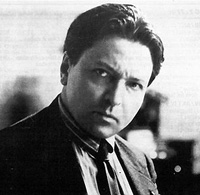 When Ilya Levinson conceived of writing a klezmer violin concerto for orchestra, he immediately thought of the form of a Rhapsody, something like Rhapsody in Blue or the Romanian Rhapsody. Thus, it seems only fitting that we close the Identities concert with George Enescu’s most famous piece. Enescu himself was a concert violinist as well as a composer and conductor. He was a bit of a prodigy, graduating from the Vienna Conservatory at the age of 13, continuing on to study in Paris. His compositions were influenced by Romanian folk music, and he was a champion of other new Romanian composers. Enescu’s musical curiosity went beyond mere provincialism, though, and included Balinese gamelan and Indian music.
When Ilya Levinson conceived of writing a klezmer violin concerto for orchestra, he immediately thought of the form of a Rhapsody, something like Rhapsody in Blue or the Romanian Rhapsody. Thus, it seems only fitting that we close the Identities concert with George Enescu’s most famous piece. Enescu himself was a concert violinist as well as a composer and conductor. He was a bit of a prodigy, graduating from the Vienna Conservatory at the age of 13, continuing on to study in Paris. His compositions were influenced by Romanian folk music, and he was a champion of other new Romanian composers. Enescu’s musical curiosity went beyond mere provincialism, though, and included Balinese gamelan and Indian music.
The Romanian Rhapsody No. 1 is the better known of the two he wrote, and he is said to have remarked that it “was just a few tunes thrown together without thinking about it". Though this is an incredible understatement of modesty, that model helped Levinson write Klezmer Rhapsody, based as it is on several traditional klezmer song forms, all of which are short in length. At any rate, Enescu completed it in 1901 at the age of 19. It is ebullient and outgoing, as is fitting for a work that takes its starting point with a folk song whose English translation is "I have a coin, and I want a drink".
The International Enescu Society has a website dedicated to all things Enescu. The video is a 1978 performance recorded in Bucharest, and it’s clear that Romanian conductor Sergiu Celibidache is enjoying himself very much.
Research and copywriting by Don Macica.
Don is a marketing consultant to the performing arts community and a contributing writer to several online publications including Chicagomusic.org and Arteyvidachicago.com. When not traveling, he lives a stone's throw from Lake Michigan in Chicago’s Rogers Park neighborhood. He is the author of Border Radio, a blog about music, migration and cultural exchange.
